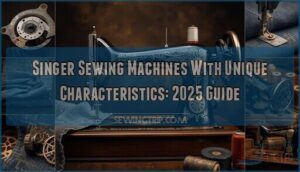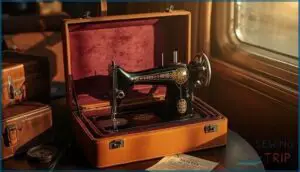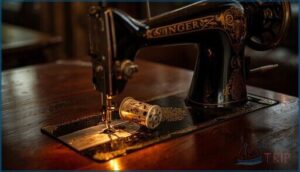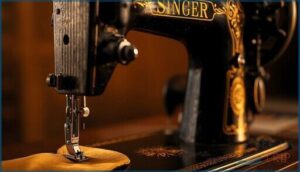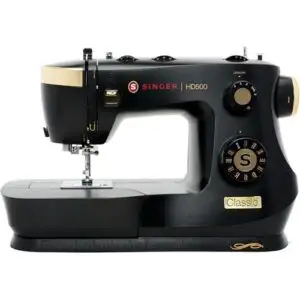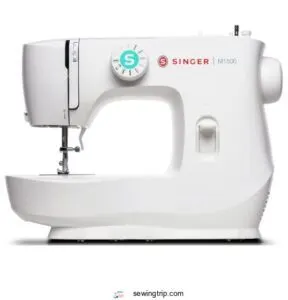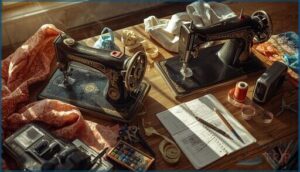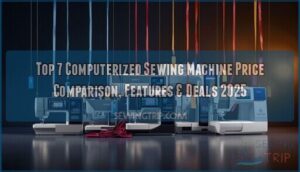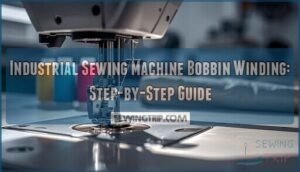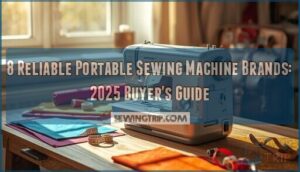This site is supported by our readers. We may earn a commission, at no cost to you, if you purchase through links.
When Isaac Singer patented his first machine in 1851, he didn’t just build a tool for stitching fabric—he sparked a mechanical revolution that still echoes through sewing rooms today. Singer sewing machines carry innovations you won’t find anywhere else, from the game-changing slant-needle that lets you see exactly where your needle drops, to vibrating shuttles that shaped how millions learned to sew.
Each model tells its own story through distinctive features: the featherweight portability of the 221, the drop-in bobbin system that ended fumbling with vertical loading, or heavy-duty motors that power through denim like butter.
Whether you’re drawn to vintage machines with all-metal gears or computerized models with 600 built-in stitches, understanding what makes each Singer unique helps you match the right machine to your projects and budget.
Table Of Contents
Key Takeaways
- Singer’s mechanical innovations like the slant-needle design (1951) and drop-in bobbin system (1902) transformed sewing ergonomics by improving visibility, reducing neck strain, and simplifying threading compared to vertical bobbin machines.
- The Singer 221 Featherweight remains the most sought-after model due to its all-metal construction, 11-pound portability, and decades of reliable performance, with collector values ranging from $200 to $5,000 depending on condition.
- Heavy-duty Singer models deliver 60% more motor power than standard machines and sew up to 1,100 stitches per minute, making them ideal for thick fabrics like denim and canvas, while computerized models offer up to 600 built-in stitches for quilting and decorative work.
- Vintage Singer machines built before 1965 feature cast-iron frames weighing 25-35 pounds with mechanical controls and can run 60-80 years with proper maintenance, while modern post-1990 models use lighter aluminum or composite construction with electronic panels and drop-in bobbins.
Unique Features of Singer Sewing Machines
Singer sewing machines stand out because they’ve introduced innovations that changed how people sew. Over more than 170 years, the company has developed features that range from clever mechanical designs to thoughtful details that make sewing easier.
Singer has spent over 170 years developing clever mechanical innovations and thoughtful details that transformed how people sew
You’ll find that understanding these unique characteristics helps you see why certain Singer models remain so valued today.
Slant-Needle and Straight-Needle Designs
When Singer introduced the slant-needle design in 1951 with the Model 301, it transformed how you see your work. The needle-bar angles between eight and sixteen degrees, giving you a clear line of sight to every stitch.
This needle angle ergonomics reduces neck strain compared to traditional straight stitch machines with vertical bobbins, while delivering speeds up to 1,600 stitches per minute with enhanced stitch quality comparison.
The Singer 401A, introduced later, also featured a solid cast aluminum body.
Drop-in Bobbin Systems
Beyond needle placement, you’ll find that bobbin threading fundamentally shapes your sewing experience. Singer’s drop-in bobbin system, introduced with the Model 66 in 1902, revolutionized sewing machine components by replacing vertical bobbin designs with a toploading straight stitch machine approach.
The clear covers let you monitor bobbin capacity at a glance, simplifying tension adjustments and jam prevention while delivering the reliable performance that defines quality sewing machine features.
Using the correct bobbin is essential because SINGER sewing requires specific bobbin classes for best performance.
Vibrating Shuttle and Rotary Hook Mechanisms
While bobbin loading matters, the internal gears driving lockstitch formation truly define your sewing machine features. Shuttle vs. Rotary mechanisms represent key technological innovations in vintage Singer sewing machines, reshaping stitch quality and maintenance needs through mechanism evolution.
Understanding the Vibration Impact:
- Vibrating shuttle models (1885-1960s) produced reliable stitches but “walked” across tables during use
- Rotary hook systems (1902 onward) reduced noise and vibration dramatically
- Speed increased from manual cranking to 1,100 stitches per minute
- Modern rotary designs lowered maintenance costs while extending part longevity
Portable and Lightweight Models
Mechanisms matter less when portability dictates your sewing life. You need compact storage solutions that don’t sacrifice functionality, which is exactly what Singer sewing machine models like the 221 Featherweight and M1500 deliver for travel sewing enthusiasts.
These portable sewing machines revolutionized DIY projects by offering space-saving designs without compromising stitch quality:
| Model | Weight | Key Advantage |
|---|---|---|
| Singer 221 Featherweight | 11 lbs 4 oz | Classic portability with 15″ width |
| SINGER M1500 Lightweight | 10 lbs | 57 stitch applications for versatility |
| Singer Fashion Mate 3333 | ~14 lbs | 750 stitches/minute speed |
| Singer 3223 | ~12 lbs | 22 total stitches for beginners |
| Singer M1500 Kit | 10 lbs | Complete travel sewing setup |
Beginner machines in Singer’s portable lineup generally measure under 12 inches tall, fitting comfortably on kitchen tables or dormitory desks.
The M1500’s 13-inch length makes it perfect for classes and workshops, while fold-up extension tables guarantee trouble-free transportation. You’ll appreciate how these designs balance aluminum chassis durability with genuine mobility, backed by Singer’s 10-year warranty on recent models.
Distinctive Aesthetic Elements
While functional precision defines Singer’s mechanics, ornate designs transformed these machines into household art pieces. You’ll discover aesthetic elements that distinguish vintage models from modern counterparts through three signature features:
- Decal Design: Red Eye patterns and Scrolls and Roses motifs adorned classic styling from the 1910s through 1970s
- Color Schemes: Black enamel with gold gave way to beige and two-tone tan finishes in the 1950s
- Surface Materials: Cast iron with baked enamel evolved into lightweight aluminum with retro design appeal
Iconic Singer Models With Distinct Characteristics
Throughout Singer’s long history, certain models have stood out for their innovative designs and lasting impact on the sewing world. These machines introduced features that changed how people sew, and many remain highly prized by collectors and working sewists today.
Let’s look at five iconic Singer models that each brought something distinct to the table.
Singer 221 Featherweight: Compact Portability
Weighing just 11 pounds, the Singer 221 Featherweight transforms your sewing practice through unparalleled portability. You’ll find this all-metal machine, produced from 1933 to 1957, fits perfectly in its travel case with a fold-away extension table.
Its compact 15-inch width doesn’t sacrifice durability—many 1930s models still operate flawlessly today.
Collectors now value restored Featherweights between $1,395 and $2,749, reflecting their enduring appeal among traveling sewists.
Singer 301: Innovative Slant-Needle Design
Introduced in 1951, the Singer 301 redefined what you’d expect from a full-size machine. Its patented slant needle sits at 60 degrees, giving you clear sight of every stitch while reducing eye strain during intricate projects.
This model stands out through five key innovations:
- Aluminum Body weighing just 16 pounds—40% lighter than earlier models
- Stitch Precision via vertical rotary hook ensuring consistent lockstitches
- Portability Standard with built-in handle for cabinet or portable use
- Centennial Editions marking Singer’s 100th anniversary (serial numbers NA000001-NA010000)
- Free-Motion Work capability through drop-feed lever for quilting
You’ll find the 301 uniquely adaptable among Vintage Singer Sewing Machines, functioning equally well in classrooms or home workshops. Its direct-drive gear system delivers strong fabric penetration while staying remarkably quiet—a genuine advancement in Sewing Machine Features for the 1950s. Among Sewing Machine Models, it earned the nickname “featherweight’s big sister.
Singer 66: Revolutionary Bobbin System
The Singer Class 66 changed everything in 1902 with the first mass-produced drop-in bobbin system—no fussy bobbin case required. You simply place the bobbin into a fixed cradle beneath the needle plate, and the rotary hook mechanics handle the rest.
This Singer sewing machine ran reliably for over 70 years in many households, influencing thread tension control and bobbin system innovation across all vintage Singer sewing machines that followed.
Singer 201: Renowned Stitch Quality
If you’re chasing precision stitching that rivals what the pros demand, the Singer 201—including the renowned Singer 201K—earns its reputation through a fully gear-driven rotary hook system.
This vintage Singer sewing machine delivers stitch consistency up to 1,100 stitches per minute with minimal fabric distortion, a feature that drove professional adoption across mid-century tailoring shops.
Its cast-iron durability and superior stitch quality keep it relevant decades later.
Singer 401: Fully Automatic Stitch Selection
When you rotate the dial on a Singer 401—or its sibling, the Singer 401A—you’re accessing what defined the Touch Sew series: fully automatic stitch selection that chose from 19 built-in patterns without external cams.
This Engineering Prowess delivered:
- Zigzag stitches and decorative stitches through a cam system expanding to 70+ patterns
- Interface Innovations including eye-level stitch charts for accessible User Operation
- Stitch Pattern Variety from blind hems to stretch seams
- All-metal gear-driven construction ensuring decades of reliability
- Market Impact exceeding 100,000 units sold between 1957–1961
Top Singer Sewing Machines With Unique Traits
Today’s Singer lineup includes machines that push beyond basic stitching, each designed with a specific purpose in mind. Whether you’re wrestling with thick denim, tackling intricate quilting patterns, or searching for something portable enough to take anywhere, there’s a model built for that exact challenge.
Let’s look at three standout options that bring something distinct to your workspace.
1. Singer Heavy Duty Sewing Machine
You’ll find the Heavy Duty series—including the Singer Heavy Duty 4423, Heavy Duty 4411, and Heavy Duty 4432—equipped with a motor power that’s 60% stronger than standard machines, delivering up to 1,100 stitches per minute.
These Singer heavy-duty sewing machines offer remarkable stitch versatility with up to 32 built-in stitches and adjustable settings. Their user design features automatic needle threaders and top drop-in bobbins, while frame durability stems from interior metal construction and stainless steel bed plates.
Satisfaction stats reveal that 79% of users recommend these machines for their reliability on demanding projects.
Best For: Sewers who regularly work with heavy fabrics like denim, canvas, and upholstery and need a reliable machine that can handle demanding projects without slowing down.
- Motor is 60% stronger than standard machines and sews up to 1,100 stitches per minute, making it twice as fast as entry-level models.
- Interior metal frame and stainless steel bed plate provide stability and durability for long-term use, with machines lasting 5-25 years depending on care.
- Versatile stitch options (23-32 built-in stitches) with adjustable length and width, plus user-friendly features like automatic needle threader and top drop-in bobbin system.
- Mostly plastic exterior construction despite the metal internal frame, which may not appeal to users wanting all-metal builds.
- Black-on-black dial markings can be hard to read, and instructions may require downloading additional resources or guides.
- Larger size (17.8 x 7.8 x 11.0 inches) and weight might not suit sewers with limited workspace or those needing a portable machine.
2. Singer Computerized Sewing and Quilting Machine
When you shift from durability to sophisticated features, computerized machines reveal their true potential. Models like the Singer Quantum Stylist 9960 deliver 600 built-in stitches at 850 stitches per minute, offering superior stitch customization and performance control.
Quilting enhancements include extension tables and programmable needle settings, while user demographics show 81% of regional consumers prefer Singer for its machine reliability.
The automatic thread trimmers and LCD screens make these computerized machines invaluable for quilting projects, backed by 2-year warranties covering major defects.
Best For: Sewists who want advanced features for quilting and detailed projects, with the flexibility to handle everything from basic stitching to intricate decorative work.
- Massive stitch library with up to 600 built-in options and automatic one-step buttonholes, giving you plenty of creative freedom for any project.
- Built-in time-savers like automatic thread trimmers, drop-in bobbin systems, and LED screens that make setup and adjustments quick and intuitive.
- Quilting-ready features including extension tables, programmable needle positions, and specialized feet for free-motion work and precise piecing.
- Heavier build (around 11-12 kg) makes portability more challenging if you need to move your machine frequently.
- Learning curve can be steep for beginners—you’ll likely need to spend time with the manual and tutorials to unlock all the features.
- Higher price point compared to mechanical machines, with most models falling in the 20,000-30,000 INR range or higher.
3. Singer M1500 Lightweight Sewing Machine Kit
If portability matters in your sewing routine, the Singer M1500 Lightweight Sewing Machine Kit weighs just 9.7 pounds while maintaining a sturdy metal frame.
You’ll access 57 stitch applications through a simple dial, with preset length and width removing guesswork for beginner sewing. This mechanical machine delivers 750 stitches per minute, works with light to medium fabrics reliably, and includes accessories like presser feet, bobbins, and measuring tools.
Warranty reliability spans 25 years for the machine head and 2 years for electrical components, making it a practical choice among Singer sewing machine models.
Best For: Beginners and casual sewers who need a portable machine for basic projects like mending, simple garments, and light crafts without complicated setup.
- Weighs only 9.7 pounds with a metal frame, making it easy to carry to classes or store in small spaces.
- 57 stitch applications with preset length and width take the guesswork out of stitch selection for new users.
- Strong warranty coverage includes 25 years on the machine head and 2 years on electrical components.
- Some users report thread jamming and needle breaking during use.
- Stitch speed of 750 per minute is slower than heavy-duty models, which may frustrate experienced sewers.
- Mixed reviews on durability and customer support quality suggest inconsistent performance across units.
Choosing The Right Singer Model for Your Needs
Selecting the right Singer sewing machine depends on understanding what separates vintage craftsmanship from modern innovation, and matching those features to your actual sewing habits. Whether you’re threading your first bobbin or tackling industrial-weight canvas, the machine that fits your needs won’t be the same as someone else’s.
Let’s break down the practical considerations that’ll help you find your ideal match.
Identifying Vintage Vs. Modern Features
You can spot the difference between vintage Singer sewing machines and modern advancements in Singer models by looking at a few telltale signs. Material Composition shifted from cast iron chassis in pre-1965 units to aluminum or composite frames after 1990. Control Mechanisms evolved from mechanical levers to electronic panels starting in 1992. Serial Numbers appear on the front panel of vintage models, but near the on/off switch on contemporary machines. Bobbin Systems transitioned from vibrating shuttle designs to drop-in systems in 95% of post-1990 units. Aesthetic Elements also changed—ornate gold decals gave way to minimalist branding.
| Feature | Vintage (Pre-1965) | Modern (Post-1990) |
|---|---|---|
| Material Composition | Cast iron, 25-35 lbs | Aluminum/composite, 12-18 lbs |
| Control Mechanisms | Mechanical levers, dials | Electronic panels, digital displays |
| Bobbin Systems | Vibrating shuttle, rotary hook | Drop-in bobbin (95% of models) |
| Aesthetic Elements | Gold decals, black enamel | Minimalist logos, colored plastics |
| Serial Numbers | Front panel or metal plate | Near on/off switch |
Identifying Singer models by year becomes straightforward once you recognize these signature differences between vintage models and their modern counterparts.
Key Considerations for Beginners and Pros
When choosing a Singer sewing machine, you’ll need to assess your skill level first. Beginners benefit from Singer models offering 6–12 built-in stitches, while sophisticated features like 417 stitch applications suit experienced users.
Project complexity, budget constraints, and space requirements also matter—vintage models demand restoration funds, whereas compact SINGER sewing machines fit tight workspaces. Feature prioritization ensures you match machine capabilities to your actual weaving and stitching goals.
Comparing Durability and Performance
Durability and performance separate Singer sewing machines across decades. Vintage all-metal Singer models like the 201 and 66 run for 60–80 years with routine care, while modern composite frames show higher failure rates.
Motor power output matters—Heavy Duty models deliver 60–70% more piercing force than standard machines. Maintenance intervals, user testimonials, and metal-versus-composite construction all predict how your Singer performs over time.
Evaluating Specialized Functions (Quilting, Heavy-Duty, Etc.)
How do specialized functions change your Singer sewing machine choice? Match your project needs to machine capabilities before you buy.
- Quilting stitch options: The Patchwork 7285Q offers 100 built-in stitches with 140 mm throat space for larger quilts, while 70% of current Singer quilting machines include programmable needle positioning for precision.
- Heavy-duty materials: The Heavy Duty series sews denim and canvas at 1,100 stitches per minute—50% faster than standard models.
- Computerized customization: Digital Singer machines preview stitch patterns on LCD screens, cutting setup time by 30% for small business adaptability.
Where to Buy and Collect Singer Machines
Finding the right Singer machine—whether you’re hunting for a vintage gem or buying a brand-new model—requires knowing where to look and what to watch for.
The marketplace has changed dramatically over the years, with online platforms now sitting alongside traditional dealers and estate sales.
Let’s explore where you can find authentic Singer machines, which retailers you can trust, and how to get the best value for your investment.
Finding Authentic Vintage Singer Models
You’ll want to start your search with serial verification, since over 21 million vintage Singer sewing machines entered the market between 1851 and 1970. Counterfeit prevalence makes authentication essential—customs seized 40 unauthorized machines in 2019 alone.
Use database usage through ISMACS or LRCrafts for model identification by year and production details. For complex cases, expert authentication provides additional confidence when collecting vintage Singer sewing machines.
Trusted Online Retailers and Marketplaces
You’ll find Singer sewing machines through authorized dealers like SewingMachinesPlus.com and VillageSewing.com, which offer warranty policies and consumer protection. Marketplace growth has boosted online access, with over 13,500 distribution points worldwide. Amazon and AliExpress rank as leading platforms, while international access extends across 50 countries.
These retailers provide both new and vintage models, ensuring you’re covered whether shopping online or offline at competitive prices.
Price Comparison and Value Tips
You’ll boost your investment by comparing prices across multiple retailers, where savings of up to 15% are possible. Used Machine Savings reach 30–60% compared to new Singer sewing machine prices, though Condition Impact Value matters—working vintage models sell for 50–80% more.
Look for Bundled Offers Value with accessories, check Collectible Model Prices at auctions, and time purchases during sales events for best Vintage Sewing Machine Value.
Frequently Asked Questions (FAQs)
What is the most sought after Singer sewing machine?
The Singer 221 Featherweight stands as the most sought-after model, with over 75 million units produced between 1933 and Collector value ranges from $200 to $5,000, depending on condition and finish.
What’s the best vintage Singer sewing machine?
The Singer 221 Featherweight stands out for stitch quality, portability, and rarity value among collectors. With over 75 million produced, it offers excellent restoration potential and user experience for vintage sewing enthusiasts.
What is the best Singer model?
There’s no single best Singer model—it depends on your needs. For heavy fabrics, the Heavy Duty 4411 excels. Quilters prefer the C7290Q. Budget-conscious beginners should explore the HD500 Classic for project suitability.
What makes a Singer sewing machine valuable?
Rarity, aesthetic condition, and functional status drive value in collecting vintage Singer sewing machines.
Historical significance and collector demand increase prices, especially for models with original decals and proven reliability across Singer’s machine legacy.
How do Singer machines handle unconventional or synthetic fabrics?
Your Singer sewing machine manages synthetic fabrics with the right needle type, stitch settings, and presser feet. Adjust tension control for knit fabrics, use specialty feet for feeding, and select appropriate needles for weaving success.
What maintenance practices are specific to unique Singer models?
Each model demands different attention. Featherweight oiling targets 10 factory points annually, slant-needle care requires micro-drop lubrication every 16 hours, and drop-in maintenance means cleaning after every few bobbins to prevent jams.
Can Singer machines be modified for left-handed users?
Most controls sit on the right, making adaptation a common need. You can reposition accessories, adjust needle placements on computerized models, or modify your workspace layout. Fully ambidextrous designs remain rare in Singer’s lineup.
Are there Singer machines designed for sewing leather?
Yes, but with limits. Singer Heavy Duty models like the 4411 handle light leather when you use proper needles and durable thread.
For serious leatherwork or heavy fabrics, industrial Singer machines offer better performance than domestic units.
How do Singers industrial models differ from home versions?
Singer sewing machine industrial models operate at 1,500 to 5,500 stitches per minute, offering exceptional durability and industrial speed.
In contrast, domestic machines prioritize home versatility, providing a lower cost analysis and broader market adoption for global manufacturing applications.
How often should I oil my Singer machine?
You’ll want to oil your Singer sewing machine monthly if you use it regularly. Light sewers can oil every three to four months, while daily users need more frequent self-maintenance.
Conclusion
The right Singer sewing machine with unique characteristics often finds you at the exact moment you need it—whether that’s a vintage 221 Featherweight at an estate sale or a computerized model when your skills outgrow your current machine.
Your choice ultimately depends on what you’ll create: heavy canvas bags need industrial motors, while delicate quilts demand precise stitch control.
Match the machine’s distinct capabilities to your projects, and you’ll discover why Singer’s innovations continue defining sewing mastery.
- https://maggieframestore.com/blogs/maggieframe-news/singer-machine-history-from-patent-wars-to-global-sewing-revolution
- https://storymaps.arcgis.com/stories/9f381317511e42e2bc4d37ccc741c034
- https://en.wikipedia.org/wiki/Singer_Corporation
- https://www.mordorintelligence.com/industry-reports/sewing-machines-market
- https://thegnomestudio.com/singer-sewing-machine-models/

